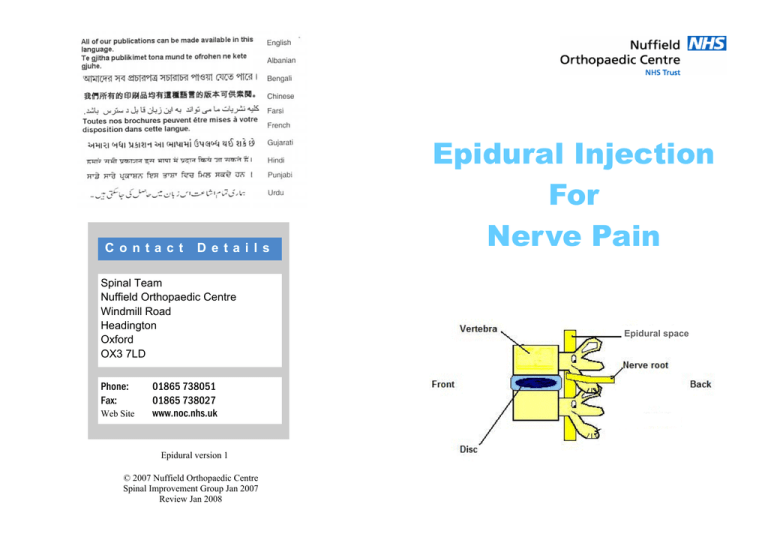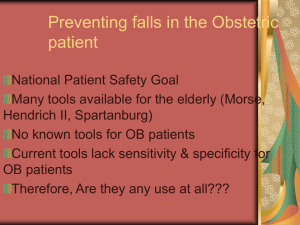Epidural Injection For Nerve Pain
advertisement

C o n ta c t D e ta i l s Spinal Team Nuffield Orthopaedic Centre Windmill Road Headington Oxford OX3 7LD Phone: Fax: Web Site 01865 738051 01865 738027 www.noc.nhs.uk Epidural version 1 © 2007 Nuffield Orthopaedic Centre Spinal Improvement Group Jan 2007 Review Jan 2008 Epidural Injection For Nerve Pain Epidural space What is an epidural ? An epidural is an injection that delivers an anaesthetic and antiinflammatory medication (steroid) directly into the epidural space in the spine. When is an epidural recommended? Spinal conditions can cause severe low back pain and/or leg pain. If the leg pain is severe and tablets and physical therapy are not helping, then an epidural injection is a non-surgical treatment option which may improve the leg pain. USEFUL TELEPHONE NUMBERS How does it work? NOC Main Switchboard - 01865 741155 Spinal pain can be caused by irritation of the nerves in the spine. Steroids have been shown to reduce inflammation. Epidural works by delivering steroids directly to the area which is irritated. The aim is to reduce inflammation in these nerves and thus alleviate pain and muscle spasm. Spinal Secretaries - 01865 738051 How long will the pain relief last? Patient Advice & Liaison Service (PALS) - 01865 738126 It can take up to a month before you begin to respond to the steroid but if it works, the pain relief can last for many months or years. How often will I need an epidural? • • • 1 One epidural steroid injection provides long-lasting pain relief for many patients, especially those who keep active. Occasionally the nerve pain improves but remains troublesome. In this case a second or even third epidural will be considered. If a you do not experience any relief from the first epidural injection, further injections will probably not be beneficial. 6 Getting back to normal How effective is epidural? The epidural steroid injection is used to give pain relief to enable you to be active. A good outcome depends on how well you get going after the epidural. Your efforts will lead to less pain, more confidence and less disability in the long term. Around 50% of individuals who undergo an epidural injection have significant relief of symptoms. However, it is unusual for the epidural to cure a patient’s condition. More likely is that the epidural helps to speed up the normal recovery process and allows an individual to return to more normal activities sooner than they would otherwise have been able to. It is therefore a treatment rather than a cure. Now is a good time to gradually build up how much you can do. Some activities may be uncomfortable at first but don’t worry that’s normal. You just need to be sensible. Pacing can help. Pacing You can pace all sorts of activities such as lifting, cycling, swimming, vacuuming, ironing and gardening. It is best to concentrate on improving one or two things at a time. The epidural steroid injection has a long history of safe use. However occasionally complications do occur. These include: • Headache may occur and sometimes this is severe and occurs in 1 out of 100 injections. The headache usually gets better within a few days. • Your blood pressure may fall, but this will settle after an hour or so. • Infections occur in 1 out of 100,000 people. Severe infections are rare, but can be serious and can be treated. Within a few months you should be doing most everyday things, including work, fairly normally. • Bleeding is a rare complication and is more common for patients with underlying bleeding disorders. Remember it is normal to have good and bad days. Even on the bad days it is important to keep going. • While extremely rare, nerve damage can occur from direct trauma from the needle, or secondarily from infection or bleeding. This occurs in about 1 out of 200,000 people. • • • 5 What are the risks of epidural? Work out how much you can do now e.g. walk 10 minutes Do 80% of this regularly e.g. walk 8 minutes 6 times per day Gradually increase the amount e.g. walk 9 minutes then after a few days walk 10 minutes etc. 2 The procedure The procedure takes about 15-20 minutes and is done by an experienced anaesthetic or orthopaedic doctor. Once you leave hospital • • Before the injection • • • A needle will be placed in a vein on the back of your hand to allow any drugs or fluids, that may be necessary, to be given. You then lie on your side and curl up as much as possible. Your back will be cleaned and a local anaesthetic will be given to numb the area. The epidural injection • • • • • • Please contact your GP if you experience a headache, a temperature or redness, swelling, tenderness, or warmth at the injection site. After the injection Hospital follow up • • To review your response to the epidural you will be seen in the orthopaedic clinic approximately six weeks after your injection. If you have not found the epidural effective for you, we will look into alternative ways of helping you to manage your pain. • 3 After the area is numb the steroid and local anaesthetic will then be injected. You may feel some discomfort or pressure in your back as the injection occurs, but this will quickly pass off You will probably experience a feeling of warmth, followed by tingling and slight numbness in the lower part of your body and legs. You may feel dizzy. This is a temporary effect caused by the local anaesthetic. • You may feel weak or tired for a little while after the injection so we advise you to rest on the day of the injection. If you develop headache after you go home you should take paracetamol or headache tablets, drink plenty of fluids and lie flat. If your headache persists for more than six hours, please contact your general practitioner. The following morning you can remove the dressing from the injection site. There may be local pain and bruising at the injection site. This is quite common and should not be of any concern. You may experience some initial discomfort for about 2 to 3 days. If so, applying ice will help reduce your discomfort. If you are currently undergoing physiotherapy, you can resume your stretching and strengthening exercises immediately after receiving your injection Normal activities (those that were done the week prior to the epidural injection) may typically be resumed the following day You will need to lie flat for up to two hours Your blood pressure will be measured at regular intervals during this time. Just occasionally there will be a drop in blood pressure following an epidural injection. This is corrected by giving fluid through the needle which has been placed in the back of the hand. As soon as you are able to stand up and walk unaided you will be discharged. 4







